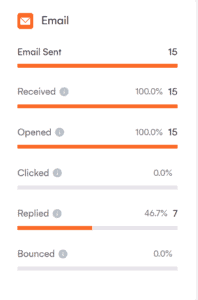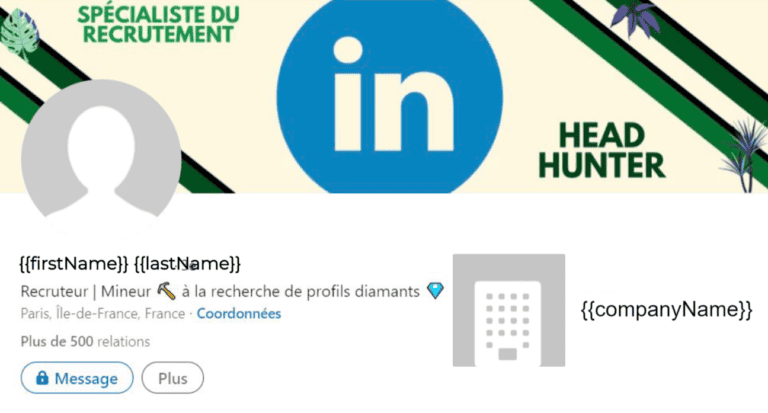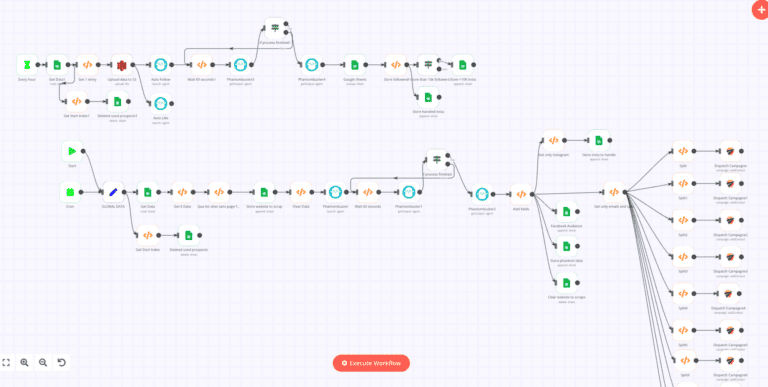B2B emailing vocabulary and explanation
Before starting this article, you’ll need to have databases of your targets’ professional emails . If this isn’t the case, I invite you to start by reading our article on enriching your prospect database.
Emailing in general takes 2 main forms: “transactional emails” and “cold prospecting emails“.
Marketing emails or “transactional emails” are used in B2B and B2C to keep your customer portfolio informed of the various platform updates, billing, onboarding, FAQs… in short! Anything that can add value to your content, they’re not for prospecting. A classic mistake, for example, is to use the “newsletter” format as a prospecting email when the objective is totally different. One allows you to nurture your customer portfolio and possibly push upsells, while the other is designed to grow your prospect pipeline.
Nurturing = Feeding your prospects with relevant articles to encourage them to make a purchase when they “themselves” identify their needs.
Upsell = additional sales
So-called “cold” emails are only used in B2B to generate appointments or demos for your sales reps (yes, RGPD obliges, personal emails are to be proscribed in your emailing campaigns).. Widely used by many companies, its drafting and deliverability are vital for a emailing campaign. What’s more, this b2b emailing campaign to support your inbound marketing strategy.
Here are the rates you should aim for on your b2b marketing emails: 70% open and 10% replies. This article will help you get them… Let’s get started!
When should you use cold email in your BtoB acquisition strategy?
The advantage of this marketing channel is that it can be used at any time in your acquisition strategy. However, some channels are better than others!
In fact, the key to a good email campaign lies in the information you have about your target and where it comes from: web scraping? Linkedin scraping? of your site? another marketing campaign?
This information will enable you to know where to place the email in your marketing automation processes.
Let’s take a look at 3 examples of classic placements for your corporate campaigns.
a) B2B emailing based on scraping :
This is the most classic location for B2B emailing. You’ve either built up a database via the web, LinkedIn (see our article on webscraping) or purchased it from one of the many data suppliers. Now it’s time to launch your email campaign.
Here, we’re 100% cold. Your objective should therefore be to talk about your target’s issues, challenges and pain points. The last thing you want to do is try to set up a meeting straight away with your first email. This will take place after the 2nd reminder e-mail. This will enable your sales force to prepare the ground and obtain information before initiating a cold call or LinkedIn contact.
The body of the email should then contain questions, not sales pitches.
Here is the structure I recommend for this type of B2B mailing:
- 1st short e-mail of 10 lines maximum with an open question
- 2nd e-mail: 1st reminder with one or two customer references. For example, the previous question was: “How do you use LinkedIn in your lead acquisition strategy? “. Here, you’d say “Jean Michel, one of our customers, uses LinkedIn to chat with his clients to invite them to webinars” or “Eric uses it, for his part, to prospect new targets to roll out his service in other verticals”.
- 3rd e-mail: 2nd reminder where you push one of your contents that may interest your target as an expert. not one that might be of interest to your target company. Subtle? No, it’s very simple. Let’s take an example. Chloé works at Slip Français as Marketing Manager. The company would be interested in the positioning of other Made In France brands on Facebook, with a table summarizing budgets etc… In this case, Chloé would be more interested in discovering a new marketing channel like Tiktok Ads or Youtube Ads.
b) B2B emailing based on a visit to your site:
Using tools such as Clearbit, Leadfeeder or Getquanty, you can find out who or what company has visited your website.
And that’s not all: most of these resources also let you find out which article has been visited the most, and how many times a prospect has visited your site. In short, it’s a great sales and marketing tool!
This makes it easy for you to adapt your email copywriting (and your marketing strategy for that matter) because you already know that your solution is of interest to them, or at least that the problem you’re solving is present in them.
Here, our aim is to trigger a response and an appointment with your prospect in order to answer his latest questions and provide him with information not available on the site. Most sites are showcases: they set out the arguments, but show little or nothing concrete. It’s in the emails that we need to be pragmatic to turn them into customers.
The strength of your message and the quality of your landing page will be the keys to your email campaigns.
Here is the structure I recommend for your B2B email templates:
- 1st e-mail reminding them that you know they’ve visited your site and that you’re assuming they have a particular problem. Don’t hesitate to list them, even if it means he’ll correct you. Attack him, not with commercial arguments, but with figures on 1 concrete case that resembles him. Imagine, Jules’ Head of Marketing visits your site and you have Celio as a customer. You’ll then send: “To give you more material, we’re working with Bernard, Head of Marketing at Celio, who has used our solution and, thanks to it, obtained +20% more appointments per sales rep”. This email must not exceed 15 lines.
- 2nd and last e-mail: You push content that complements what they’ve already visited, and you punctuate your sales argument with a Call To Action to get your prospect to make an appointment. If you have a lot of content, I recommend you take a look at : Plezi
c) B2B emailing from another campaign for multi-channel marketing
When I say campaign, I mean a previous b2b or other email campaign that didn’t get any response from your prospects on another outbound channel such as cold calling, Linkedin or a direct message on Twitter.
Your database should therefore be divided according to 2 indicators:
1) Whether or not the person has read your previous messages. If the person has read your previous messages, you need to use the same logic in this database as if they had visited your website, attacking them with reassurance levers: references, case studies, testimonials…
2) If the person hasn’t read your previous messages, it’s because the previously chosen acquisition channel wasn’t the right one, but not necessarily your copywriting. We’ll take a look at the tools later, and I’ll recommend the A/B testing technique.
Here is the structure I recommend for this type of B2B mailing:
- 1st email with 2/3 sales arguments with a tagline like “I’ve tried to contact you via Linkedin but without success, I’m convinced that our solution will bring value to {{companyname}}”. No, the last word isn’t an error in the article, it’s a merge tag or custom variable 😉
- 2nd e mail where you simply send a reminder without adding any more
- 3rd and last e-mail: you send a case study or figures on your previous customers. Don’t try to sell your product directly, but sell an exchange to see if your product is relevant to their needs.
We’ve seen classic pitches and short sequences, but I wouldn’t advise you to exceed 3 mails to avoid being flagged as spam and destroying your deliverability rate. To optimize it, you can call on Tristan, one of our experts on this subject == Contact Tristan
B2B emailing can also be used between different types of multi-channel campaigns, as it offers greater possibilities in terms of personalization. Sales are an important objective, but don’t overlook the fact that simple tips or a high-value-added page are key resources in your overall marketing automation strategy.
Would you like support with your B2B email campaign?
What’s good copywriting for B2B emailing?
And no, don’t be fooled, there is NO miracle template in copywriting, because it’s just like your graphic identity – it belongs to you and your company alone.
The tone you use, the content, your customer portfolio, etc… All this will have a direct impact on the content of your messages… It’s a real challenge! The quality of upstream data is important, and social networks are often neglected, even though they enable you to quickly get the latest news about the company you’re prospecting.
On the other hand, there are some good practices to adopt for B2B emailing.
The subject line, a key element for opening a cold email
I’m about to state the obvious, but the subject line of your emails has a direct impact on the open rate. Why remind us of this? Because all too often, I see email subject lines that start or introduce the argument… and that’s not where they belong.
Its purpose is not to convince your prospect, but just to get him to open it! No sales here! So forget this kind of email subject line: “{{firstname}}, new tips to increase your leads”.
An email subject should be flashy , short, and arouse curiosity or even humor!
A good email subject should therefore :
- to have 4/5 words and no more! Otherwise your prospect will receive a cut object like this one:

- Not a complete sentence with subject, verb and complement. No question, no interrogation
- Masquerading as an internal email
- A multi-faceted approach
- Avoid using {{firstName}} in the subject line, which is reserved for transactional emails and is overly automated.
- Avoid emoticons and lexical fields such as “free”, “offered” etc… as you may end up in spam.
A good way to find out what not to do is to check your spam!
Examples of good email subject lines that have achieved open rates of over 70%.
- LinkedIn account rental
- Collaboration: {{companyName}} – Agency 1988
- “Not applicable
- RE :
- DNS problem


The content of your B2B email campaigns:
B2B emailing has a much more corporate dimension than other campaigns (e.g. SMS, LinkedIn). Your emails should have a certain structure that you can put in any order you like, but it must contain the following information:
Framework :
- Context
- Issues
- Solution
- Call To Action
1) Context lets your prospect know why and for what purpose you’re contacting them. It’s important to put it at the beginning so that the prospect reads the rest. A prospect spends about 3 seconds deciding whether or not to trash your e-mail. It must be impactful and, above all, precise.
As you can see from the previous images, my audiences are small because they’ve been refined as much as possible so that I can adapt the copywriting accordingly. Sending the same email to thousands of people may have a satisfying “that’s it, I’m done for the week” effect, but it will have little or no impact at all. Not everything can be customized with tools, and merge tags are designed to support, not replace, well-targeted copywriting.
2) The issue can either concern your prospect’s company or the prospect himself. Depending on your target audience and its job title, your problem will take a different form. A manager’s job is to report on results, whereas a line manager’s job is to get results.
Take MirrorProfiles, for example, which offers LinkedIn account rentals. For the Sales manager, the problem would be “How do you manage your sales reps’ LinkedIn prospecting?”. For sales, it would be: “How do you get past LinkedIn quotas for your prospecting?”. This can be asked in the form of a question, which I recommend because the “?” is a visual anchor where your prospect will be drawn to read it. Indeed, a question is engaging. It can also be posed in the form of a challenge. “Today, your Linkedin acquisition channel depends on your sales reps. If they’re forced to leave {{companyname}}, you’ll lose your lead pool.
3) The solution is the part (finally) where you introduce your company and explain your main sales arguments in 2/3 bullet points. To test your b2b email copywriting, I advise you not to start with generic arguments, which won’t set you apart from your competitors, but to impose a theme on yourself. The 2/3 features of your product/service will serve as an argument. For example, if your theme is “Increase prospecting on LinkedIn”, the 2/3 arguments/features would be as follows:
- An additional LinkedIn account represents 500 more prospects contacted per week
- Verticalizing 1 LinkedIn account on 1 target allows you to work on adapted branding
- Automate serenely on an account belonging to {{companyname}} and not to one of your sales representatives
4) The CTA or “Call to action is very classic. If I can give you a little advice, avoid calendly or shared calendars via hubspot etc… Even if this technology is very practical for both, it turns out that on my campaign stats, I get more appointments using the classic method. You can also try redirecting them to a page specific to their domains.
To finish this section, here’s a small example of an email that had an 85% open rate, 24% response rate and 13 appointments generated out of a volume of 106 people.
Target: Talent Acquisition for a 24-employee company recruiting a Business Developer profile on LinkedIn.
Subject : {{firstName}}, {{Firstnamebusinessdeveloper}} is leaving…
Email :
“
Hello {{firstName}} ,
Background :
In this case, I don’t know if {{Firstnamebusinessdeveloper}} is planning to leave, but one thing’s for sure: you’re looking to strengthen your sales team! I would like to present to you by video our solution for increasing the prospecting capacity of {{Firstnamebusinessdeveloper}}.
Issues
It’s hard for a company of twenty or so people to attract business developers, let alone recruit a dozen! How can you increase your lead pipeline without recruiting an army of salespeople?
Solution:
What I propose is to rent a LinkedIn profile to double your sales force’s prospecting capacity:
- An additional LinkedIn account represents 500 more prospects contacted per week
- Verticalizing 1 LinkedIn account for 1 target allows you to work on tailored branding
- Automate serenely on an account belonging to {{companyname}} and not to one of your sales representatives
CTA
Would you be available for a chat this week or next?
A pleasure
//signature//
“
The frequency of reminders, as mentioned at the beginning of this article, will enable you to do 2 things:
- Don’t look like a spammer
- Show up in your prospect’s inbox when they look at it.
The last point is important, and for once, whether you’re in sales or marketing, we agree.
You won’t send at the same time if you’re approaching craftsmen as if you’re approaching CEOs. You can’t be afraid of test marketing and start from a caricatured vision. Craftsmen are on site during the day and check their emails at lunchtime and after work. So, set up to send emails between 12pm and 2pm and after 6pm. CEOs often have a “0 mail inbox” challenge, setting up Friday morning mailings between 6am and 8am.
Selling is also a question of timing.
Would you like support with your B2B email campaign?
What tools can be used to transform B2B emailing into a true acquisition channel?
Now that we’ve seen when and how to do our B2B emailing, I’m going to recommend the emailing tools that allow you to send them (yes, it’s the whole point of growth hacking to avoid copy/paste 😉 ). However, you don’t have to automate everything, as we saw in this article: What should I automate as a salesperson?
In order, here are the software packages I recommend for B2B email automation:
1st : Lemlist
It’s the number 1 platform for quality B2B emailing. You can add as many custom variables as there are columns in your database. It also features native integration with Dropcontact for database enrichment. And the icing on the cake: personalized images that you can insert directly into your e-mails. A real “icebreaker” for your prospects, if your service or product lends itself to it, it can be extremely effective.
Another example is MirrorProfiles, which, thanks to Lemlist, can send a preview of a LinkedIn account branded with the salesperson’s color and image.

The end result is an image like this when the prospect receives the e-mail:

Not bad, eh? 😉
2nd: Emelia
Very good emailing tool and much cheaper than Lemlist without the personalized image. It’s packed with features and can be easily interfaced with other software or platforms (that’s for the growth-minded among you). A small example of a Thomas de la growth équipe workflow with N8N:

If you would like more details on this type of workflow, please contact our expert Romain on this subject == Contact Romain
3rd: The Growth Machine
A multi-channel tool par excellence, with a comprehensive emailing section and the option of using the “Spin” technique. The latter makes it possible to contact people from the same company with different copywriting on the same audience, without having to repeat a campaign. Those who have already tested automation software know that it’s a big time-saver 😉
Bonus: Uclic.co and Hyperise but that’s for another article on personalizing your prospecting 😉
I hope this article has taught you some things you can quickly put into action in your B2B email campaigns. If you’d like to go further, don’t hesitate to get in touch with the team, we can help you with any of the topics covered 😉





